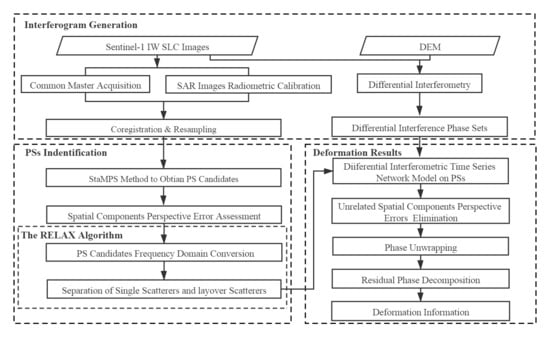Integrating RELAX with PS-InSAR Technique to Improve Identification of Persistent Scatterers for Land Subsidence Monitoring
Abstract
1. Introduction
2. Theoretical Background
2.1. PS-InSAR Technique
2.2. Spectral Analysis Methods
2.2.1. Beam-Forming (BF)
2.2.2. Singular Value Decomposition (SVD)
2.2.3. RELAX Algorithm
3. Data and Methods
3.1. Study Area
3.2. Data
3.3. Methods
3.3.1. Part 1—Selection of Spectral Analysis Method
3.3.2. Part 2—StaMPS for Obtaining Persistent Scatterer Candidates (PSC)
3.3.3. Part 3—The Spectral Analysis Method RELAX Combined with the PS-InSAR Technique
4. Results
4.1. Model Simulations
4.2. PS Identification
4.3. Land Subsidence Monitoring and Validation
5. Discussion
6. Conclusions
Author Contributions
Funding
Conflicts of Interest
References
- Chaussard, E.; Wdowinski, S.; Cabral-Cano, E.; Amelung, F. Land subsidence in central Mexico detected by ALOS InSAR time-series. Remote Sens. Environ. 2014, 140, 94–106. [Google Scholar] [CrossRef]
- Lin, H.; Ma, P.F.; Wang, W.X. Urban Infrastructure Health Monitoring with Spaceborne Multi-temporal Synthetic Aperture Radar Interferometry. Acta Geod. Cartogr. Sin. 2017, 46, 1421–1433. [Google Scholar] [CrossRef]
- Hooper, A.; Zebker, H.A. Phase unwrapping in three dimensions with application to InSAR time series. JOSAA 2007, 24, 2737–2747. [Google Scholar] [CrossRef]
- Crosetto, M.; Monserrat, O.; Cuevas-Gonzalez, M. Persistent Scatterer Interferometry: A review. ISPSR J. Photogramm. Remote Sens. 2016, 115, 78–89. [Google Scholar] [CrossRef]
- Ferretti, A.; Prati, C.; Rocca, F. Permanent scatterers in SAR interferometry. IEEE Trans. Geosci. Remote Sens. 2001, 39, 8–20. [Google Scholar] [CrossRef]
- Hooper, A.; Zebker, H.; Segall, P. A new Method for Measuring Deformation on Volcanoes and Other Natural Terrains Deformation Using InSAR Persistent Scatterers. Geophys. Res. Lett. 2004, 31, 1–5. [Google Scholar] [CrossRef]
- Ferretti, A.; Prati, C.; Rocca, F. Nonlinear Subsidence Rate Estimation Using Permanent Scatterers in Differential SAR Interferometry. IEEE Trans. Geosci. Remote Sens. 2002, 38, 2202–2212. [Google Scholar] [CrossRef]
- Mora, O.; Mallorqui, J.J.; Duro, J. Linear and nonlinear terrain deformation maps from a reduced set of interferometric SAR images. IEEE Trans. Geosci. Remote Sens. 2003, 41, 2243–2253. [Google Scholar] [CrossRef]
- Berardino, P.; Fornaro, G.; Lanari, R.; Sansosti, E. A new algorithm for surface deformation monitoring based on small baseline differential SAR interferograms. IEEE Trans. Geosci. Remote Sens. 2002, 40, 2375–2383. [Google Scholar] [CrossRef]
- Ferretti, A.; Fumagalli, A.; Novali, F.; Prati, C.; Rocca, F.; Rucci, A. A newalgorithm for processing interferometric data-stacks: SqueeSAR. IEEE Trans. Geosci. Remote Sens. 2011, 49, 3460–3470. [Google Scholar] [CrossRef]
- Goel, K.; Adam, N. A distributed scatterer interferometry approach for precision monitoring of known surface deformation phenomena. IEEE Trans. Geosci. Remote Sens. 2014, 52, 5454–5468. [Google Scholar] [CrossRef]
- Devanthéry, N.; Crosetto, M.; Monserrat, O.; Cuevas-González, M.; Crippa, B. An approach to persistent scatterer interferometry. Remote Sens. 2014, 6, 6662–6679. [Google Scholar] [CrossRef]
- Confuorto, P.; Martire, D.D.; Centolanza, G.; Iglesias, R.; Mallorqui, J.J.; Novellino, A.; Plank, S.; Ramondini, M.; Thuro, K.; Calcaterra, D. Post-failure evolution analysis of a rainfall-triggered landslide by multi-temporal interferometry SAR approaches integrated with geotechnical analysis. Remote Sens. Environ. 2017, 188, 51–72. [Google Scholar] [CrossRef]
- Iglesias, R.; Mallorqui, J.J.; Monells, D.; López-Martínez, C.; Fabregas, X.; Aguasca, A.; Gili, J.A.; Corominas, J. PSI Deformation Map Retrieval by Means of Temporal Sublook Coherence on Reduced Sets of SAR Images. Remote Sens. 2015, 7, 530–563. [Google Scholar] [CrossRef]
- Liao, M.S.; Wei, L.H.; Wang, Z.Y.; Balz, T.; Zhang, L. Compressive Sensing in High-resolution 3D SAR Tomography of Urban Scenarios. J. Radars 2015, 4, 123–129. [Google Scholar] [CrossRef]
- Fornaro, G.; Lombardini, F.; Pauciullo, A.; Reale, D.; Viviani, F. Tomographic Processing of Interferometric SAR Data: Developments, applications, and future research perspectives. IEEE Signal Process. Mag. 2014, 31, 41–50. [Google Scholar] [CrossRef]
- Chen, F.L.; Wu, Y.H.; Zhang, Y.M. Motion and Structural Instability Monitoring of Ming Dynasty City Walls by Two-Step Tomo-PSInSAR Approach in Nanjing City, China. Remote Sens. 2017, 9, 371. [Google Scholar] [CrossRef]
- Ma, P.F.; Liu, Y.Z.; Wang, W.X.; Lin, L. Optimization of PSInSAR networks with application to TomoSAR for full detection of single and double persistent scatterers. Remote Sens. Lett. 2019, 10, 717–725. [Google Scholar] [CrossRef]
- De, M.A.; Fornaro, G.; Pauciullo, A. Detection of single scatterers in multidimensional SAR imaging. IEEE Trans. Geosci. Remote Sens. 2009, 47, 2284–2297. [Google Scholar] [CrossRef]
- Zhang, M.; Burbey, T.J. Inverse modeling using PS-InSAR data for improved land subsidence simulation in Las Vegas Valley, Nevada. Hydrol. Process 2016. [Google Scholar] [CrossRef]
- Fornaro, G.; Serafino, F.; Soldovieri, F. Three–Dimensional Focusing with Multipass SAR Data. IEEE Trans. Geosci. Remote Sens. 2003, 41, 507–517. [Google Scholar] [CrossRef]
- Fornaro, G.; Serafino, F. Imaging of Single and Double Scatterers in Urban Areas via SAR Tomography. IEEE Trans. Geosci. Remote Sens. 2006, 44, 3497–3505. [Google Scholar] [CrossRef]
- Ren, X.Z.; Yang, R.L. Improved RELAX Algorithm for SAR Tomography. J. Data Acquis. Proc. 2010, 25, 302–306. [Google Scholar] [CrossRef]
- Stoica, P.; Nehorai, A. Performance study of conditional and unconditional direction-of-arrival estimation. IEEE Trans. Acoust. Speech. Signal Proc. 1990, 38, 1783–1795. [Google Scholar] [CrossRef]
- Fornaro, G.; Serafino, F.; Lombardini, F. Three-dimensional multipass SAR focusing: Experiments with long-term spaceborne data. IEEE Trans. Geosci. Remote Sens. 2005, 43, 702–712. [Google Scholar] [CrossRef]
- Fornaro, G.; Monti, G.A. Joint multibaseline SAR interferometry. EURASIP J. Appl. Signal Process. 2005, 20, 3194–3205. [Google Scholar] [CrossRef]
- Li, J.; Stoica, P.; Zheng, D. An Efficient Algorithm for Two-dimensional Frequency Estimation. Multidimens. Syst. Signal Proc. 1996, 7, 151–178. [Google Scholar] [CrossRef]
- Pauciullo, A.; Reale, D.; De, M.A. Detection of Double Scatterers in SAR Tomography. IEEE Trans. Geosci. Remote Sens. 2012, 50, 3567–3586. [Google Scholar] [CrossRef]
- Budillon, A.; Schirinzi, G. GLRT Based on Support Estimation for Multiple Scatterers Detection in SAR Tomography. IEEE J. Appl. Earth Observ. Remote Sens. 2016, 9, 1086–1094. [Google Scholar] [CrossRef]
- Dănișor, C.; Fornaro, G.; Pauciullo, A. Super-Resolution Multi-Look Detection in SAR Tomography. Remote Sens. 2018, 10, 1894. [Google Scholar] [CrossRef]
- Zhou, C.D.; Gong, H.L.; Zhang, Y.Q.; Warner, T.; Wang, C. Spatiotemporal Evolution of Land Subsidence in the Beijing Plain 2003–2015 Using Persistent Scatterer Interferometry (PSI) with Multi-Source SAR Data. Remote Sens. 2018, 10, 552. [Google Scholar] [CrossRef]
- Zhang, Y.H.; Wu, H.A.; Kang, Y.H.; Zhu, C.G. Ground Subsidence in the Beijing-Tianjin-Hebei Region from 1992 to2014 Revealed by Multiple SAR Stacks. Remote Sens. 2016, 8, 675. [Google Scholar] [CrossRef]
- Holzner, J.; Bamler, R. Burst-Mode and ScanSAR Interferometry. IEEE Trans. Geosci. Remote Sens. 2002, 40, 1917–1934. [Google Scholar] [CrossRef]
- González, P.J.; Bagnardi, M.; Hooper, A.J. The 2014-2015 eruption of Fogo volcano: Geodetic modeling of Sentinel-1 TOPS interferometry. Geophys. Res. Lett. 2015, 42, 9239–9246. [Google Scholar] [CrossRef]
- Shang, D. WorldView-2 high-resolution satellite successfully launched. Remote Sens. Land Res. 2009, 4, 109. [Google Scholar]
- Lin, H.; Ma, P.F.; Lan, H.X. Basic Principles, Key Techniques and Applications of Tomographic SAR Imaging. J. Geomatics. 2015, 40, 1–6. [Google Scholar] [CrossRef]
- Sandwell, D.; Mellors, R.; Tong, X.; Wei, M.; Wessel, P. Open Radar Interferometry Software for Mapping Surface Deformation. Eos Trans. AGU 2011, 92, 234. [Google Scholar] [CrossRef]
- Farr, T.; Rosen, P.; Caro, E.; Crippen, R.; Duren, R.; Hensley, S.; Alsdorf, D. The shuttle radar topography mission. Rev. Geophys. 2007, 45. [Google Scholar] [CrossRef]
- Hooper, A.; Bekaert, D.; Spaans, K.; Arıkan, M. Recent advances in SAR interferometry time series analysis for measuring crustal deformation. Tectonophysics 2011, 514, 1–13. [Google Scholar] [CrossRef]
- Bekaert, D.P.S.; Walters, R.J.; Wright, T.J.; Hooper, A.J.; Parker, D.J. Statistical comparison of InSAR tropospheric correction techniques. Remote Sens. Environ. 2015, 170, 40–47. [Google Scholar] [CrossRef]
- Dee, D.P.; Uppala, S.M.; Simmons, A.J.; Berrisford, P.; Poli, P.; Kobayashi, S.; Andrea, U. The ERA-Interim reanalysis: Configuration and performance of the data assimilation system. Q. J. R. Meteorol. Soc. 2011, 137, 553–597. [Google Scholar] [CrossRef]
- Wang, B.C.; Yuan, S.L.; Wang, J.H.; Guo, L.F. Accuracy Analysis and Evaluation of InSAR Land Subsidence Monitoring. Remote Sens. Inf. 2015, 30, 8–13. [Google Scholar] [CrossRef]
- Yuan, Y.; Zhou, C.; Qin, B. A Nearest Neighbor Index Clustering Algorithm for Ecological Regionalization Based on Multi-layer Grid Model. Geo-Inf. Sci. 2011, 13, 1–11. [Google Scholar] [CrossRef]
- Yun, Y.; Lü, X.L.; Fu, X.K. Application of spaceborne interferometric synthetic aperture radar to geohazard monitoring. J. Radars 2020, 9, 73–85. [Google Scholar] [CrossRef]

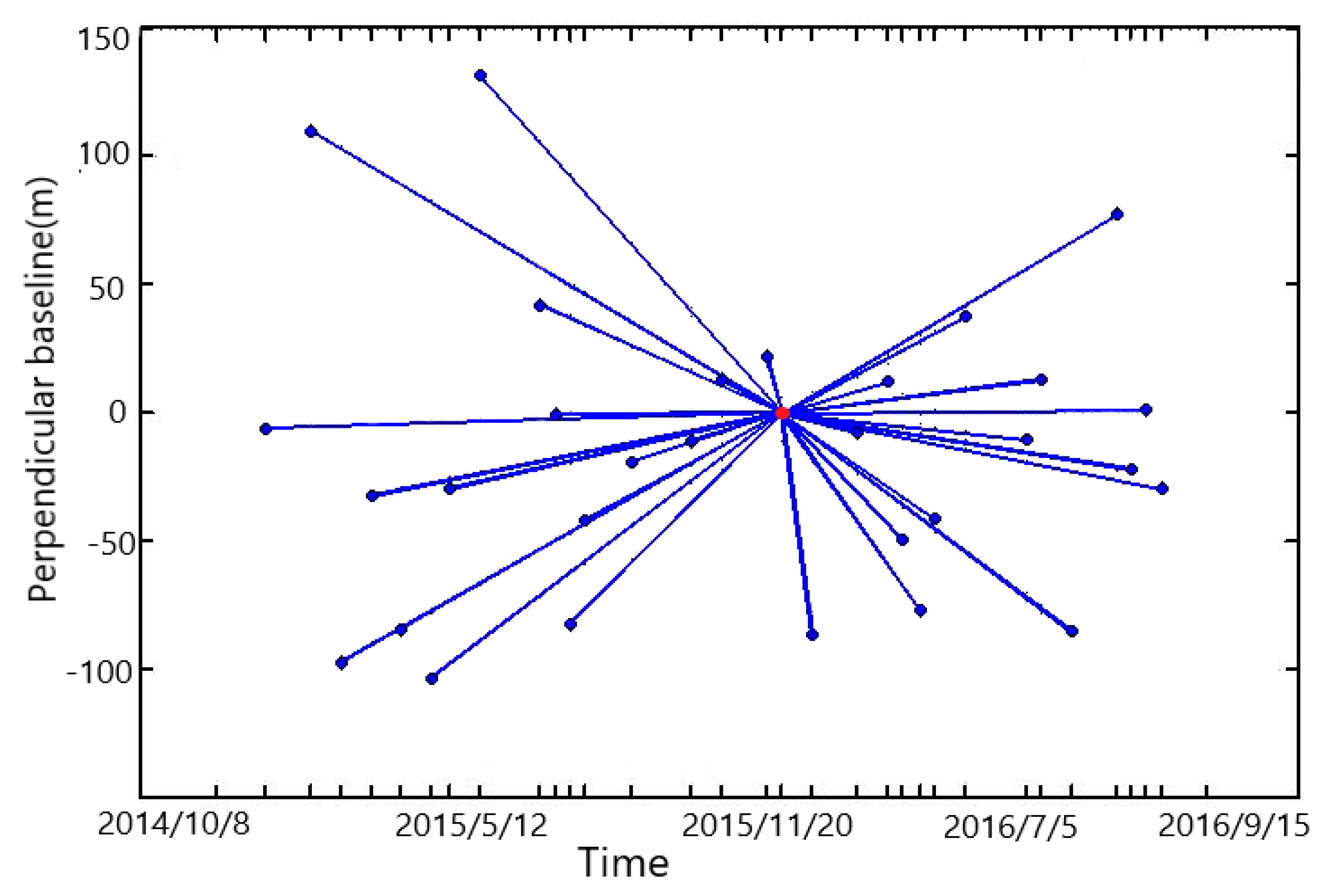
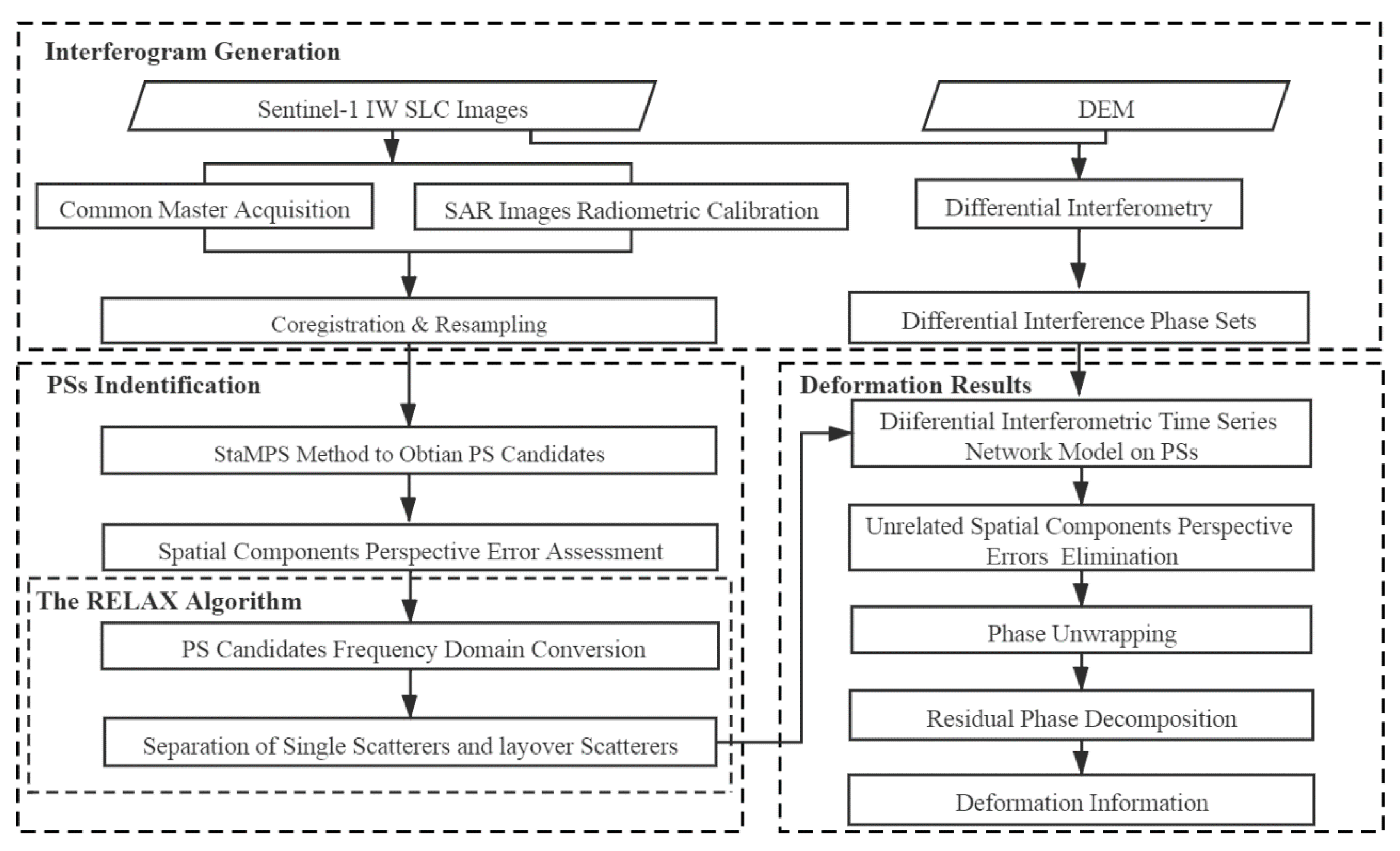
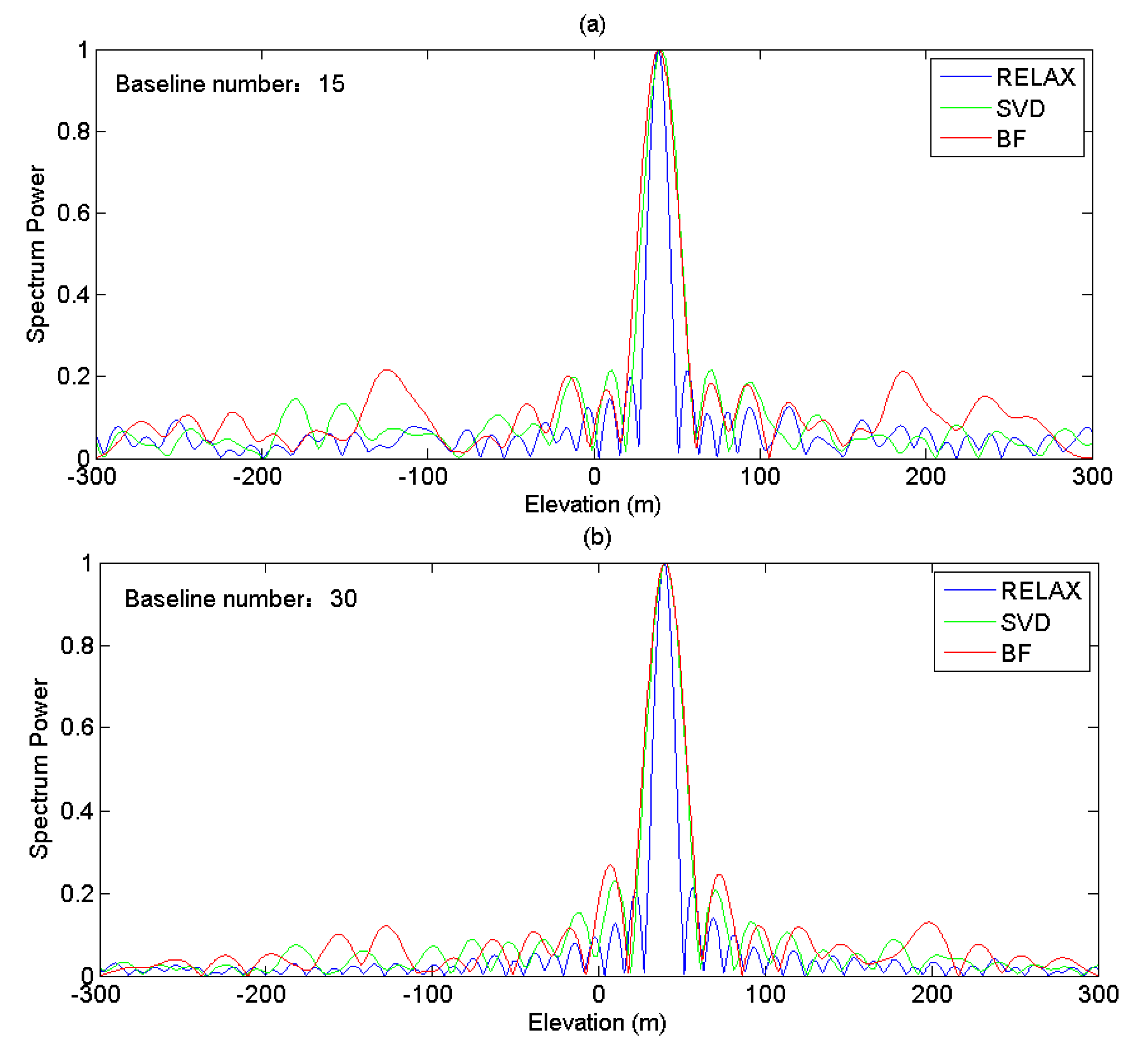
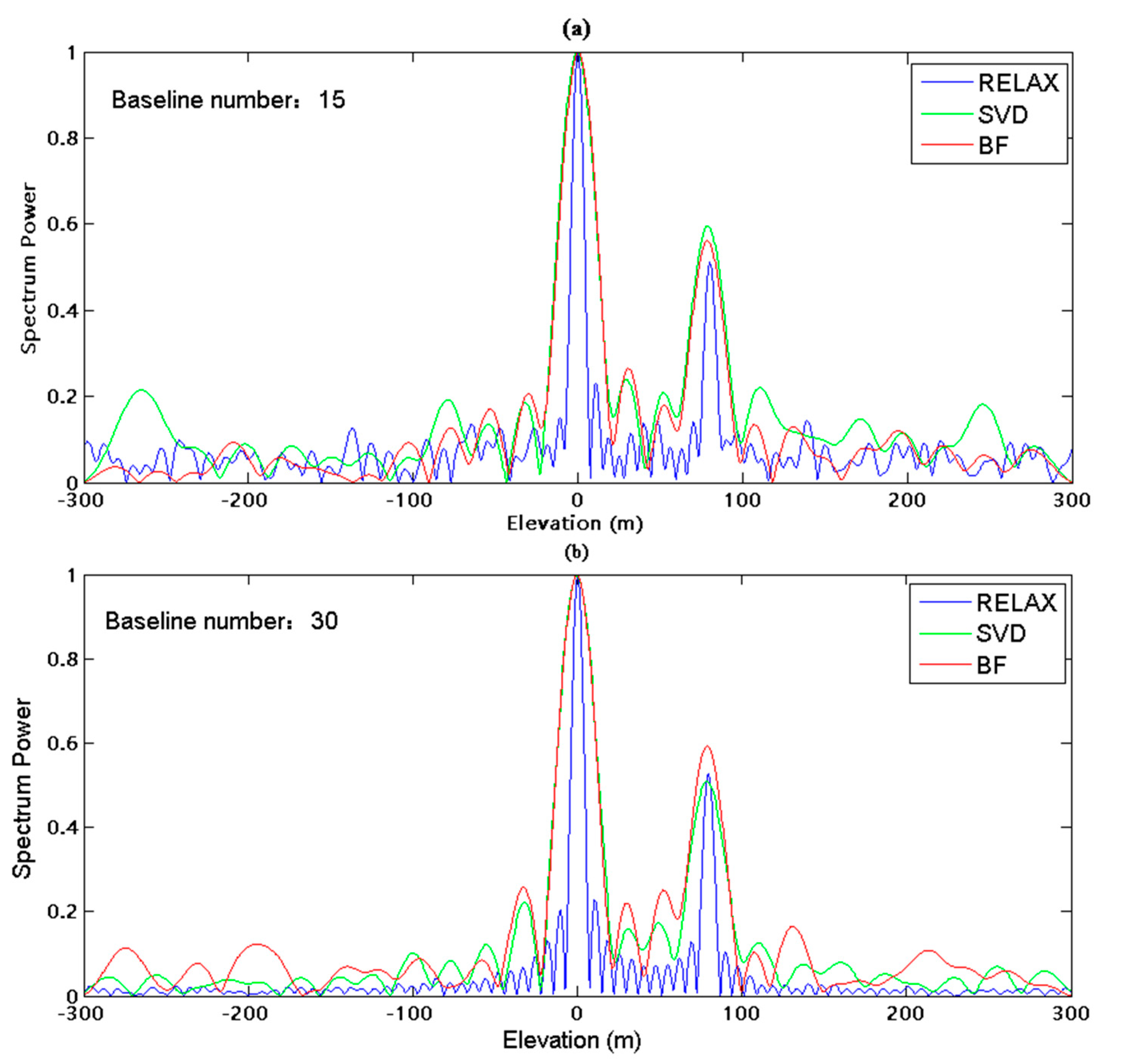

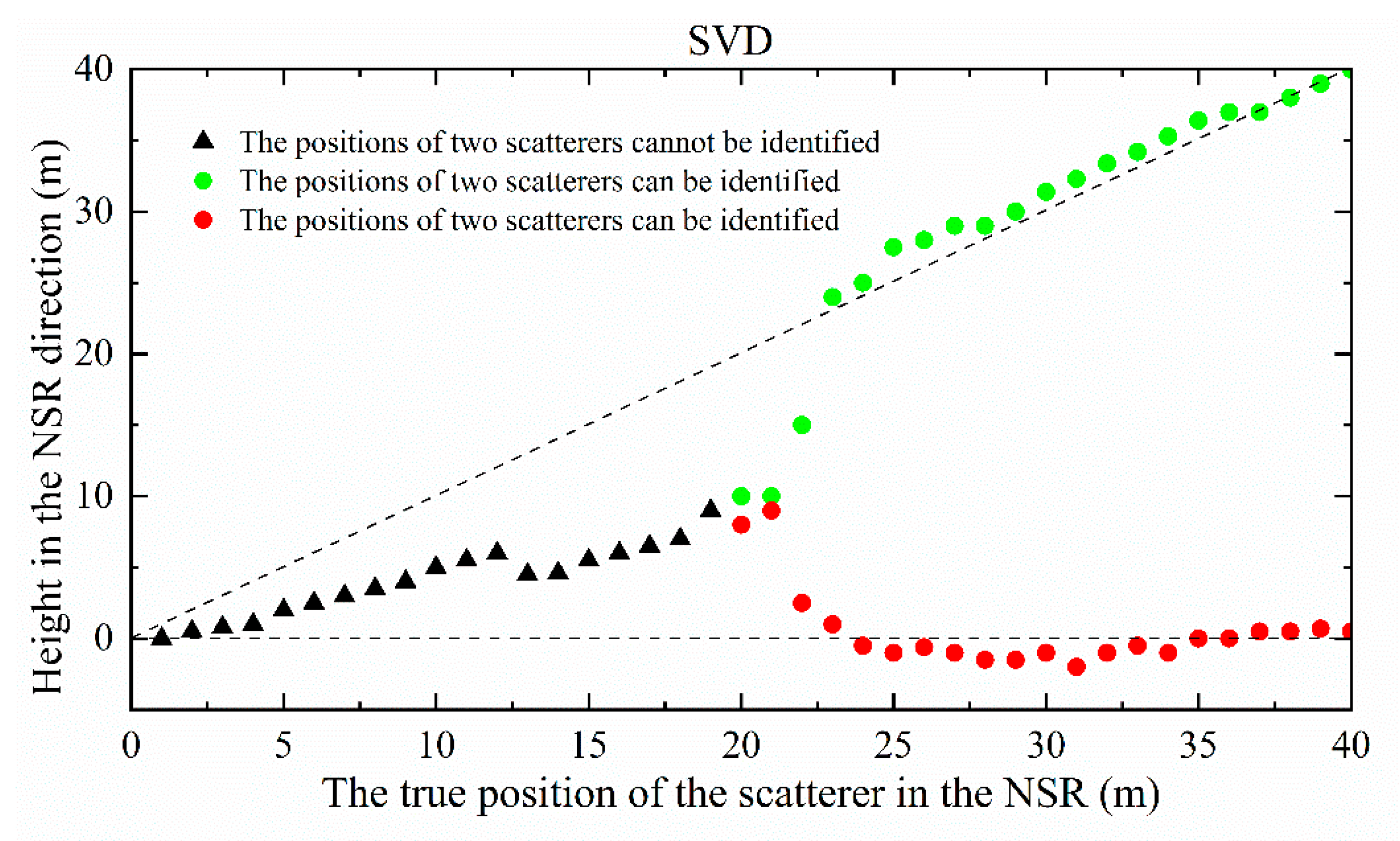

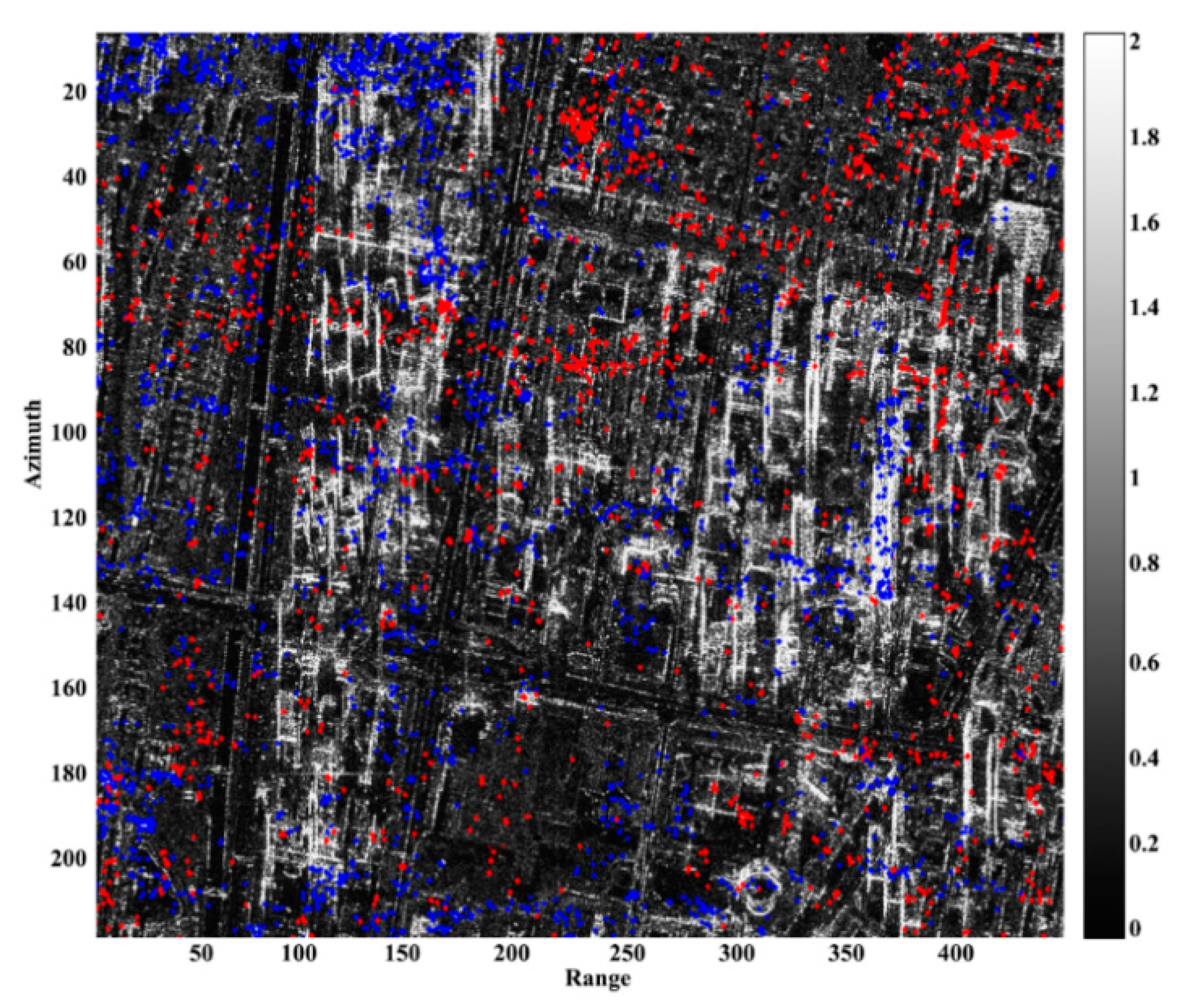
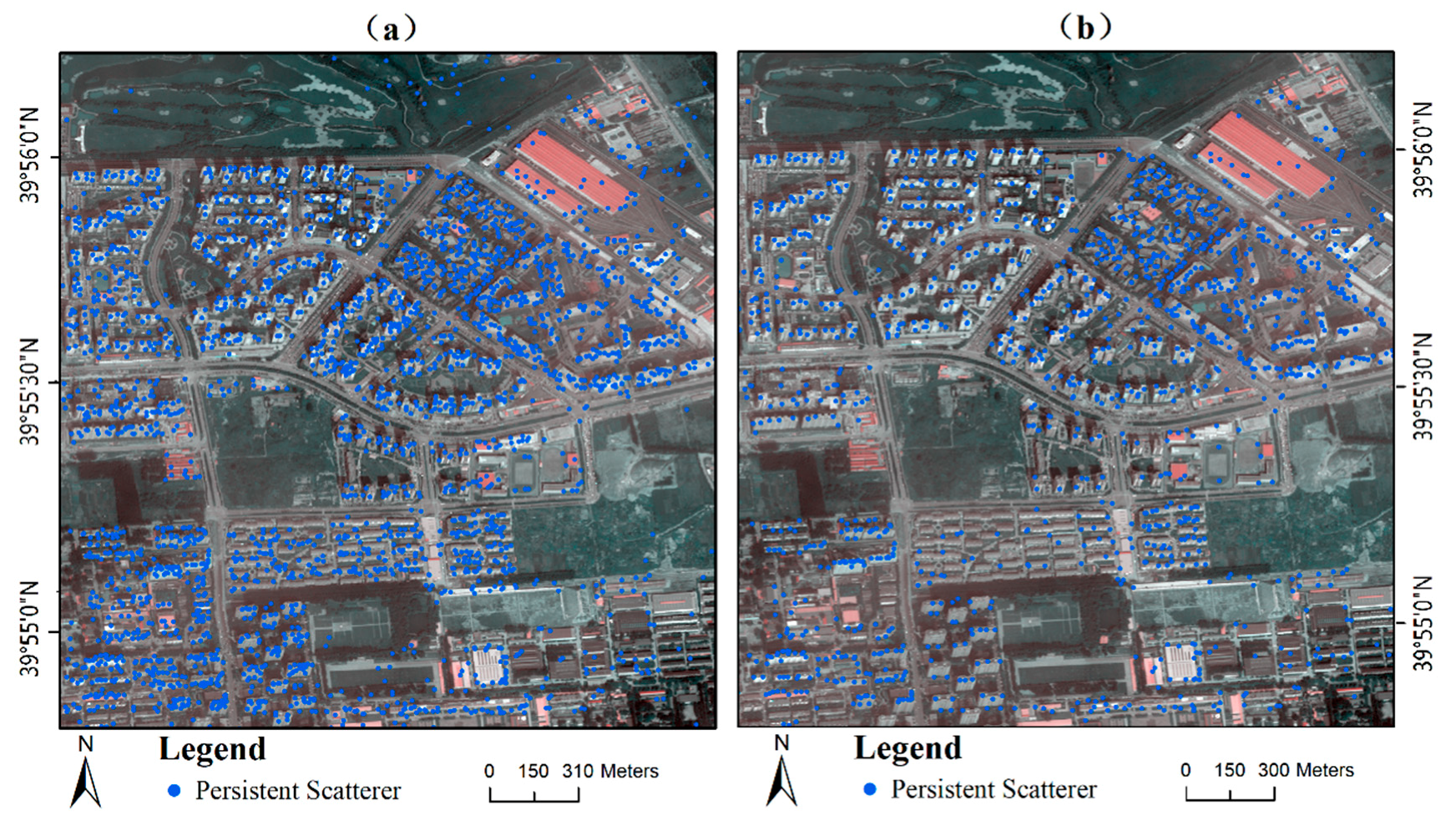

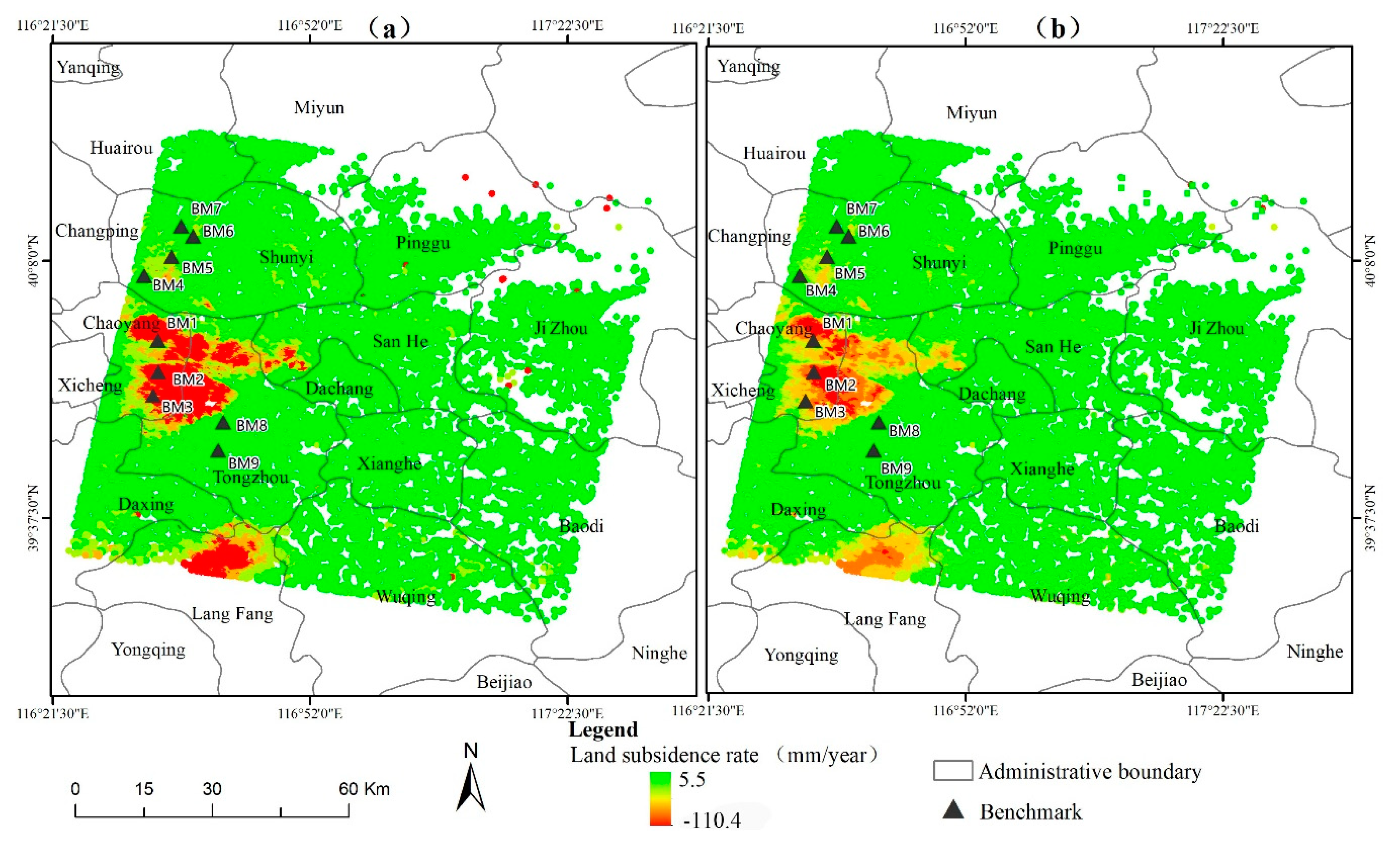
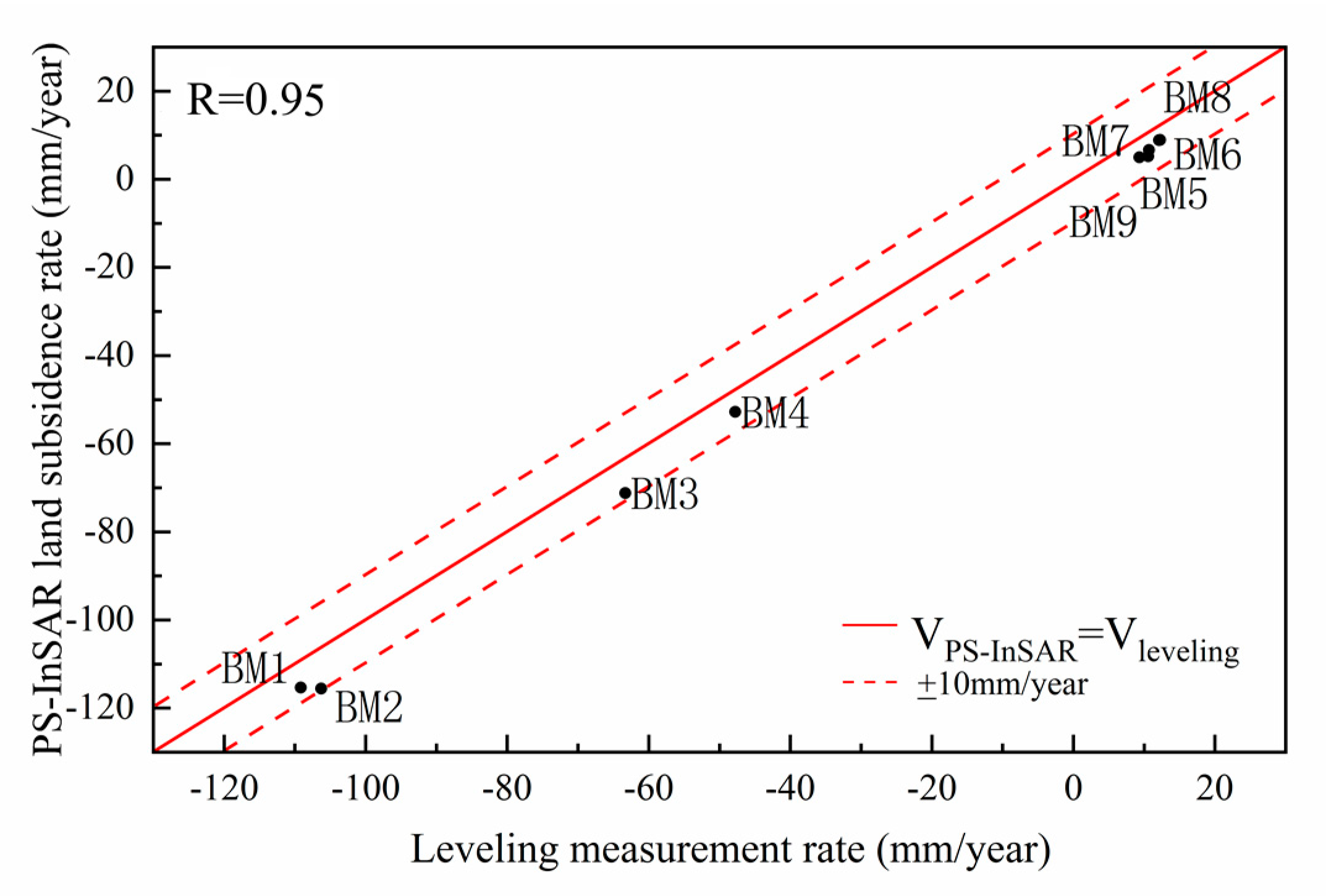
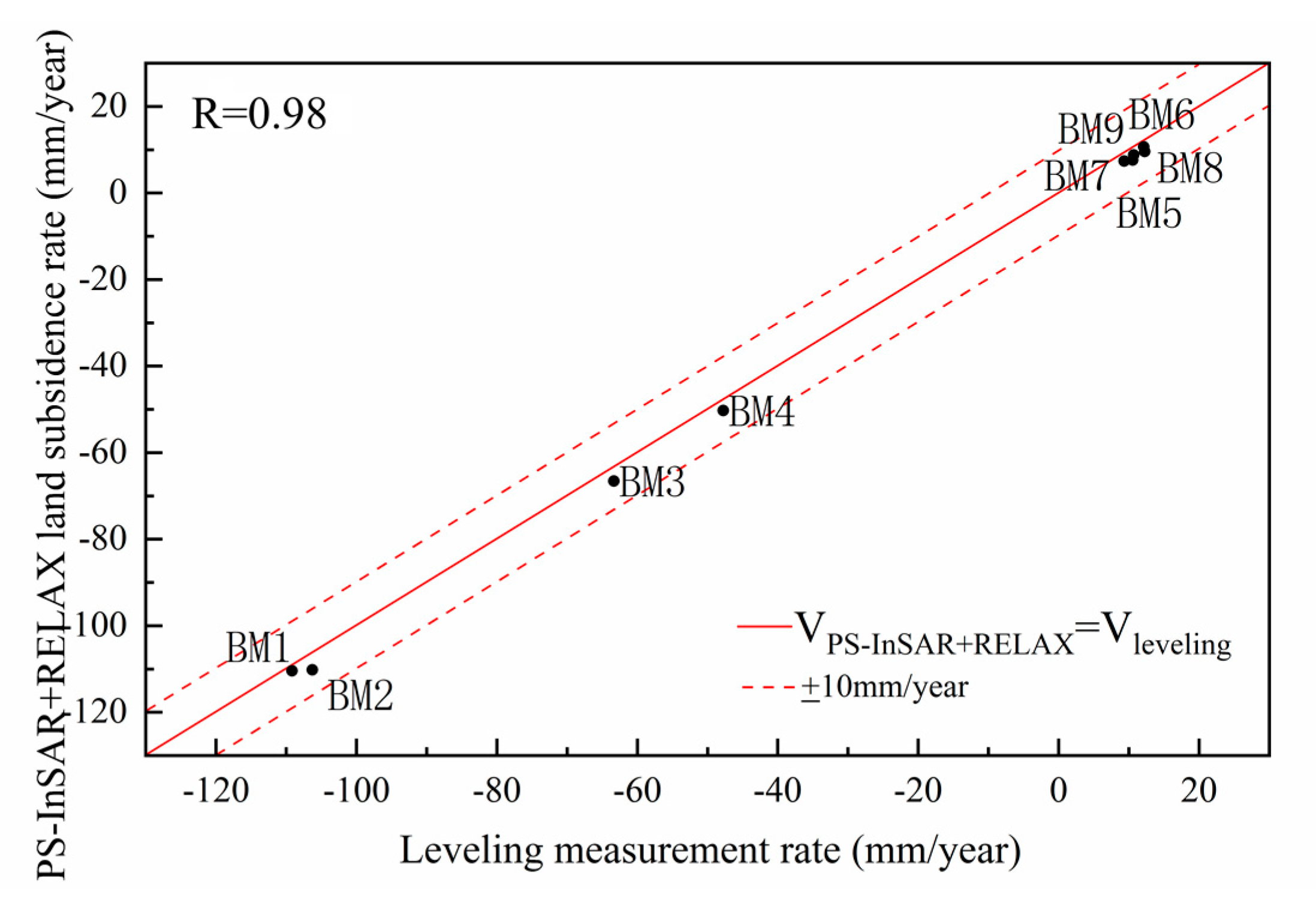
| Parameter | Value |
|---|---|
| Wavelength | 5.6 cm |
| Incidence Angle | 39.6° |
| Orbital Height | 693 km |
| Polarizations | HH + HV, VH + VV, HH, VV |
| Spatial Resolution | 20 m (ground range) × 5 m (azimuth) |
| Pixel Spacing | 2.3 m (slant range) × 13.9 m (azimuth) |
| Parameter | Value |
|---|---|
| Wavelength () | 5.6 cm |
| Average Satellite Height (H) | 690 km |
| Average Distance (Rg) | 690 km |
| Total Perpendicular baseline Length (Bv) | 300 m |
| Number of Flights (N) | 31 |
| Methods | The Number of PS | The Density of PS/km2 | Intensity Mean | Intensity Standard Deviation |
|---|---|---|---|---|
| PS-InSAR | 16352 | 1876 | 14.62 | 8.62 |
| PS-InSAR+RELAX | 14258 | 1725 | 68.42 | 4.68 |
| Benchmarks Number | Leveling Measurement | PS-InSAR | Difference |
|---|---|---|---|
| BM1 | −109.15 | −116.57 | 7.42 |
| BM2 | −106.26 | −115.58 | 9.32 |
| BM3 | −63.32 | −70.31 | 6.99 |
| BM4 | 47.76 | −53.35 | 5.59 |
| BM5 | 10.57 | 7.29 | 3.28 |
| BM6 | 12.12 | 9.75 | 2.37 |
| BM7 | 9.34 | 5.98 | 3.36 |
| BM8 | 12.25 | 6.96 | 5.29 |
| BM9 | 10.69 | 5.64 | 5.05 |
| Mean Standard deviation | 5.41 2.11 |
| Benchmarks Number | Leveling Measurement | PS-InSAR+RELAX | Difference |
|---|---|---|---|
| BM1 | −109.15 | −110.43 | 1.28 |
| BM2 | −106.26 | −110.21 | 3.95 |
| BM3 | −63.32 | −65.69 | 2.37 |
| BM4 | 47.76 | −50.21 | 2.45 |
| BM5 | 10.57 | 8.59 | 1.98 |
| BM6 | 12.12 | 10.67 | 1.45 |
| BM7 | 9.34 | 7.15 | 2.19 |
| BM8 | 12.25 | 10.67 | 1.58 |
| BM9 | 10.69 | 8.86 | 1.83 |
| Mean Standard deviation | 2.12 0.75 |
© 2020 by the authors. Licensee MDPI, Basel, Switzerland. This article is an open access article distributed under the terms and conditions of the Creative Commons Attribution (CC BY) license (http://creativecommons.org/licenses/by/4.0/).
Share and Cite
Zhou, D.; Simic-Milas, A.; Yu, J.; Zhu, L.; Chen, B.; Muhetaer, N. Integrating RELAX with PS-InSAR Technique to Improve Identification of Persistent Scatterers for Land Subsidence Monitoring. Remote Sens. 2020, 12, 2730. https://doi.org/10.3390/rs12172730
Zhou D, Simic-Milas A, Yu J, Zhu L, Chen B, Muhetaer N. Integrating RELAX with PS-InSAR Technique to Improve Identification of Persistent Scatterers for Land Subsidence Monitoring. Remote Sensing. 2020; 12(17):2730. https://doi.org/10.3390/rs12172730
Chicago/Turabian StyleZhou, Di, Anita Simic-Milas, Jie Yu, Lin Zhu, Beibei Chen, and Nijiati Muhetaer. 2020. "Integrating RELAX with PS-InSAR Technique to Improve Identification of Persistent Scatterers for Land Subsidence Monitoring" Remote Sensing 12, no. 17: 2730. https://doi.org/10.3390/rs12172730
APA StyleZhou, D., Simic-Milas, A., Yu, J., Zhu, L., Chen, B., & Muhetaer, N. (2020). Integrating RELAX with PS-InSAR Technique to Improve Identification of Persistent Scatterers for Land Subsidence Monitoring. Remote Sensing, 12(17), 2730. https://doi.org/10.3390/rs12172730




